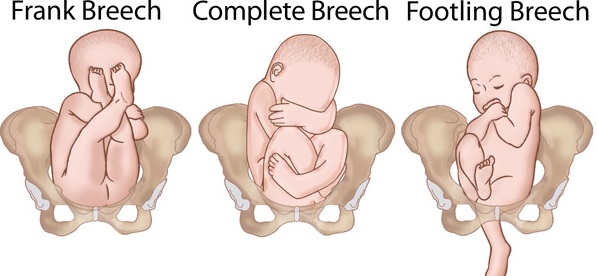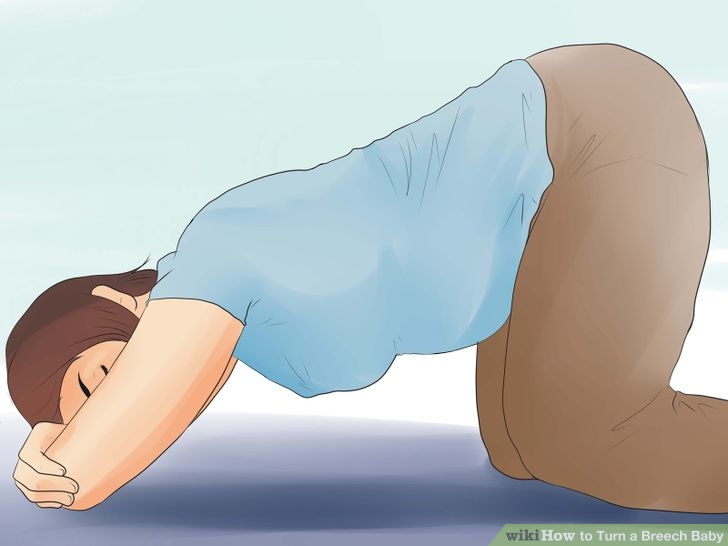In general, babies move into their normal delivery position a few weeks before the due date with their heads closer to the birth canal. However, this does not occur all the time and some babies are positioned in a breech presentation, where the baby’s buttocks and/or feet are closer to the birth canal. There are three types of breech positions: frank breech, complete breech and footling breech. The breech position can make the delivery process more difficult and dangerous. Then is there a possibility for the baby to turn to a normal birth position?

Should You Worry If Your Baby Is Breech at 32 Weeks?
Normally, you need not to worry if you have a breech baby at 32 weeks. There is still enough time for your baby to turn into a normal birth position before birth. Sometimes, babies turn into a normal birth position by the 34th week of pregnancy. However, if your baby is still in a breech position even after the 36th week of pregnancy, then you should start getting worried. But even at this stage, there is also a possibility for the baby to turn into a normal birth position. Sometimes, the baby even turns into its normal position just before labor starts. However, you should note that as the pregnancy progresses, it gets more difficult for the baby to flip the head down. If the baby is not in its normal position as it should be, rerouting him/her might be an option if you want to avoid C-section.
How to Turn Your Breech Baby at 32 Weeks?
Here are some measures you can take to help move your baby's head down to the birth canal.
1. Breech Tilt Exercise
 The breech tilt exercise is one of the most commonly used exercises to turn the baby from a breech position. It helps to tuck the baby's chin, which is the first step in flipping over. In order to perform the exercise correctly, you need to lie down and elevate your hip 9 to 12 inches above the head with pillows. You are supposed to do this exercise three times a day for at least ten to fifteen minutes each time. The best time to do the exercise is when the stomach is empty and the baby is active. Try to relax when performing the exercise and do not tense the abdominal muscles.
The breech tilt exercise is one of the most commonly used exercises to turn the baby from a breech position. It helps to tuck the baby's chin, which is the first step in flipping over. In order to perform the exercise correctly, you need to lie down and elevate your hip 9 to 12 inches above the head with pillows. You are supposed to do this exercise three times a day for at least ten to fifteen minutes each time. The best time to do the exercise is when the stomach is empty and the baby is active. Try to relax when performing the exercise and do not tense the abdominal muscles.
2. Knee-to-Chest Exercise
 The knee-to-chest exercise is helpful too. This exercise encourages your baby to turn into a normal position by using the force of gravity. You need to get down on your knees, resting your forearms on the ground. Lift your butt high in the air while tucking your chin. You should stick to this position at least two times a day for five to fifteen minutes. This knee-to-chest exercise allows your uterus to expand, making more room for the baby to turn into the normal birth position.
The knee-to-chest exercise is helpful too. This exercise encourages your baby to turn into a normal position by using the force of gravity. You need to get down on your knees, resting your forearms on the ground. Lift your butt high in the air while tucking your chin. You should stick to this position at least two times a day for five to fifteen minutes. This knee-to-chest exercise allows your uterus to expand, making more room for the baby to turn into the normal birth position.
3. Swimming
Swimming in the pool is one of the measures to help a breech baby at 32 weeks. It helps and encourages your baby to move. You can also try flipping back and forth while you are in the water. Diving in the pool and even crouch on the bottom of the pool in deep water are also good choices.
4. Good Posture
It is always recommended to position your feet properly, pull the abdomen in, pull the butt in, straighten your back and allow your shoulders to get a normal position. Good and correct posture will give your baby enough room in the uterus so he/she can turn easily into the correct birth position.
5. Hot and Cold Packs
One smart idea to trick your baby to flip over is by applying cold on the top of the uterus or applying warm on the end of the uterus. With the external stimulation, your baby is more likely to get away from the cold area, and move toward the warm area, flipping into its correct position. There is no need for you to worry about the safety of this technique. It is completely safe for you and your baby.
6. Music or Talking
One great option to help your baby turn into a normal birth position is talking to your baby or playing music. Your partner could just talk to the baby by placing his mouth on the lower part of the abdomen. You could also place the headphones on the lower part of your abdomen and play the music you like to your baby.
7. The Webster’s Technique
The Webster's technique consists of two things: first, it puts the sacrum and the pelvis bones into balance and proper alignment. Secondly, it helps relax the round ligaments around the uterus. This technique can help make enough room for your baby to move downward. Remember that Webster's technique is a process and not a single event. You will need a couple of appointments during a week in the last weeks of pregnancy. Make sure to receive treatment from an experienced professional.
8. Hypnosis
Hypnosis is another choice when turning your breech baby at 32 weeks. With the help of hypnosis, the mother gets deeply relaxed, which means that her muscles relax and the uterus expands so as to encourage the baby to turn into the right position. A reputable hypnotherapist is preferable.
9. External Cephalic Version (ECV)
Once your baby is not turned into a normal position by the 37th week of pregnancy, it is less likely that it will turn on its own by the time of birth. You should consider the external cephalic version. During ECV, medications will be first used to relax the uterus, followed by external pushing of the baby. Pressure is applied on the lower part of the abdomen and the whole procedure is monitored through ultrasound. The baby's heart rate will also be closely observed. It has been estimated that the procedure is successful in about 58% of all the cases with breech presentation. However, ECV is not always recommended. ECV should not be performed when it is a twin pregnancy or when the amniotic fluid levels are lower than the normal level.
What Should Be Your Delivery Plan If You Have Breech Birth?
If ECV fails, there is a great possibility that your baby will remain in a breech position until the time of birth. Normally, you and your doctor will need to discuss all the possibilities of giving birth to your child. You should talk to your doctor if the vaginal birth is still an option for you. In certain cases, vaginal delivery with a breech presentation is allowed, but C-section is a more common choice. In cases of vaginal breech birth, the main risks are damage to the baby during delivery as well as the need of an emergency C-section in labor. Keep in mind that this type of delivery is more likely to get complicated than normal vaginal deliveries with a head-down position.
